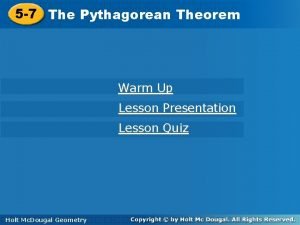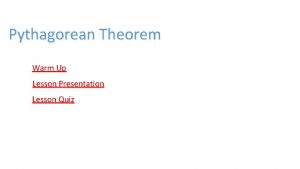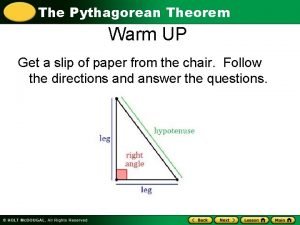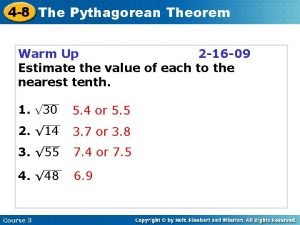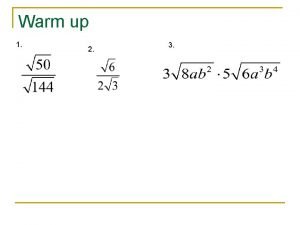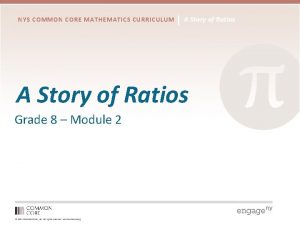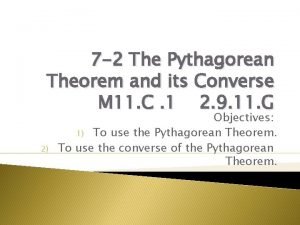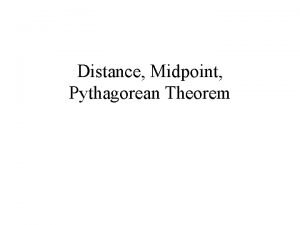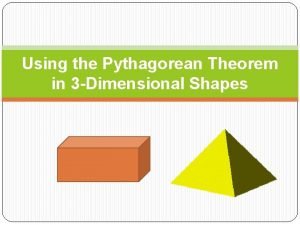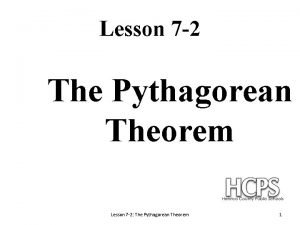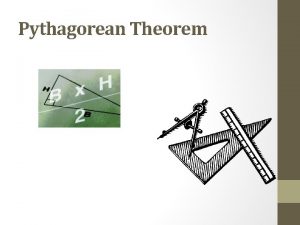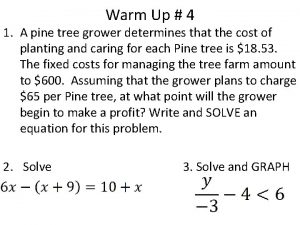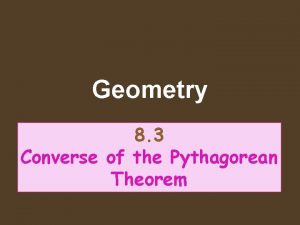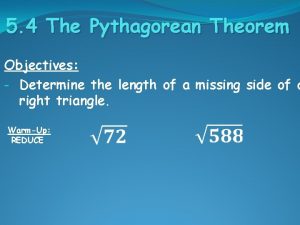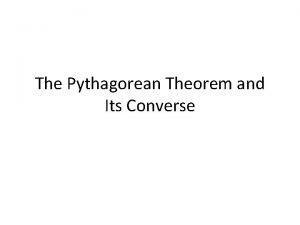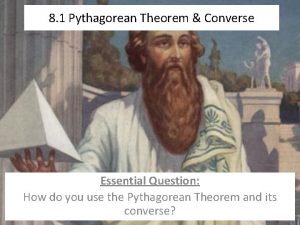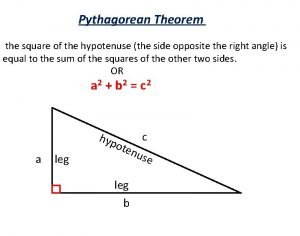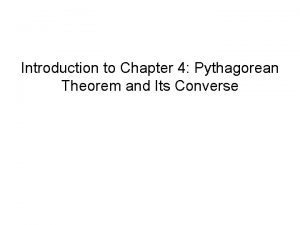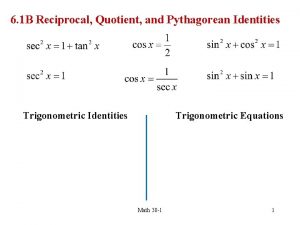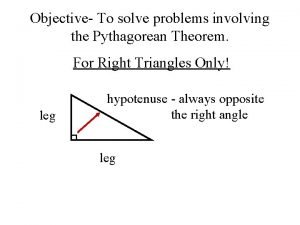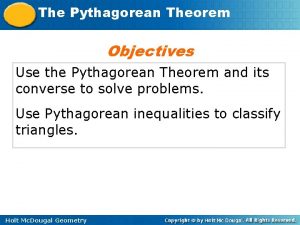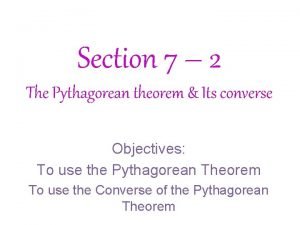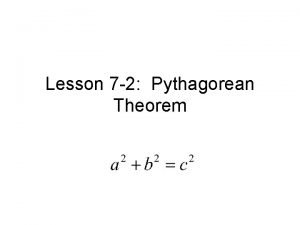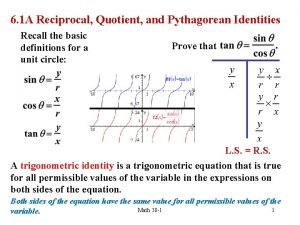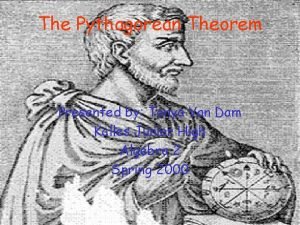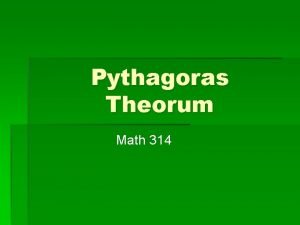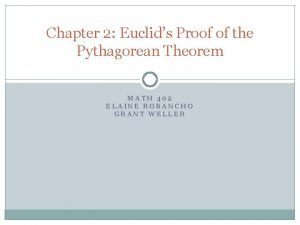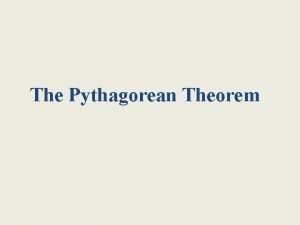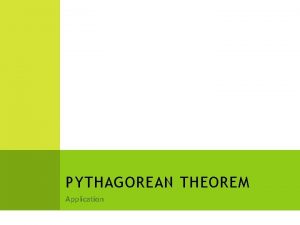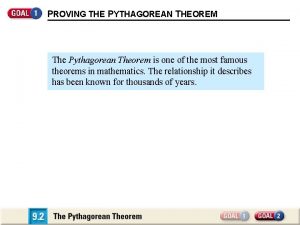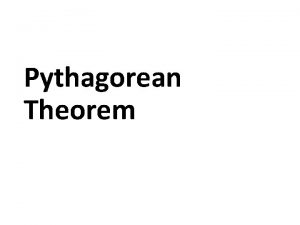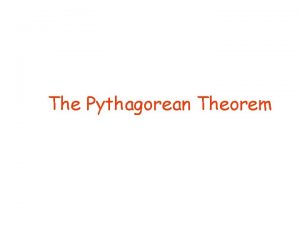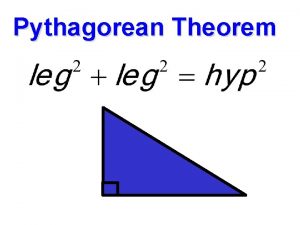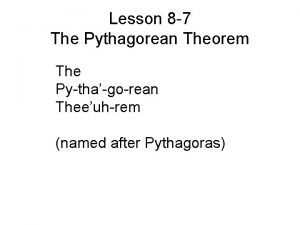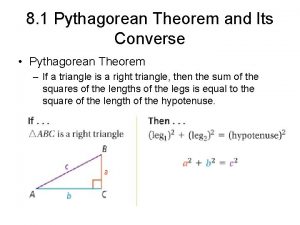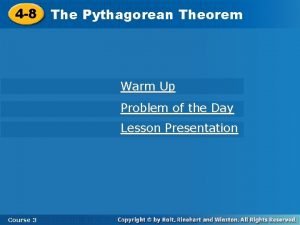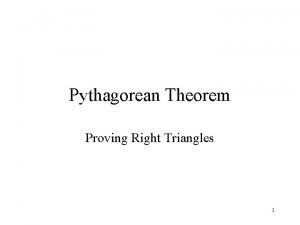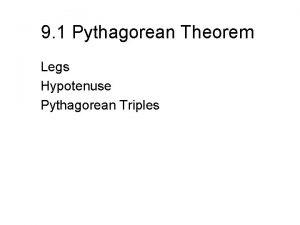5 7 The The Pythagorean Theorem Warm Up


































- Slides: 34

5 -7 The The. Pythagorean. Theorem Warm Up Lesson Presentation Lesson Quiz Holt Geometry

5 -7 The Pythagorean Theorem Warm Up Classify each triangle by its angle measures. 1. 2. acute 3. Simplify right 12 4. If a = 6, b = 7, and c = 12, find a 2 + b 2 and find c 2. Which value is greater? 85; 144; c 2 Holt Geometry

5 -7 The Pythagorean Theorem Objectives Use the Pythagorean Theorem and its converse to solve problems. Use Pythagorean inequalities to classify triangles. Holt Geometry

5 -7 The Pythagorean Theorem Vocabulary Pythagorean triple Holt Geometry

5 -7 The Pythagorean Theorem is probably the most famous mathematical relationship. As you learned in Lesson 1 -6, it states that in a right triangle, the sum of the squares of the lengths of the legs equals the square of the length of the hypotenuse. a 2 + b 2 = c 2 Holt Geometry

5 -7 The Pythagorean Theorem Example 1 A: Using the Pythagorean Theorem Find the value of x. Give your answer in simplest radical form. a 2 + b 2 = c 2 Pythagorean Theorem 22 + 62 = x 2 Substitute 2 for a, 6 for b, and x for c. 40 = x 2 Simplify. Find the positive square root. Simplify the radical. Holt Geometry

5 -7 The Pythagorean Theorem Example 1 B: Using the Pythagorean Theorem Find the value of x. Give your answer in simplest radical form. a 2 + b 2 = c 2 Pythagorean Theorem (x – 2)2 + 42 = x 2 Substitute x – 2 for a, 4 for b, and x for c. x 2 – 4 x + 4 + 16 = x 2 Multiply. – 4 x + 20 = 0 Combine like terms. 20 = 4 x Add 4 x to both sides. 5=x Holt Geometry Divide both sides by 4.

5 -7 The Pythagorean Theorem Check It Out! Example 1 a Find the value of x. Give your answer in simplest radical form. a 2 + b 2 = c 2 Pythagorean Theorem 42 + 82 = x 2 Substitute 4 for a, 8 for b, and x for c. 80 = x 2 Simplify. Find the positive square root. Simplify the radical. Holt Geometry

5 -7 The Pythagorean Theorem Check It Out! Example 1 b Find the value of x. Give your answer in simplest radical form. a 2 + b 2 = c 2 x 2 + 122 = (x + Pythagorean Theorem 4)2 Substitute x for a, 12 for b, and x + 4 for c. x 2 + 144 = x 2 + 8 x + 16 Multiply. 128 = 8 x 16 = x Holt Geometry Combine like terms. Divide both sides by 8.

5 -7 The Pythagorean Theorem Example 2: Crafts Application Randy is building a rectangular picture frame. He wants the ratio of the length to the width to be 3: 1 and the diagonal to be 12 centimeters. How wide should the frame be? Round to the nearest tenth of a centimeter. Let l and w be the length and width in centimeters of the picture. Then l: w = 3: 1, so l = 3 w. Holt Geometry

5 -7 The Pythagorean Theorem Example 2 Continued a 2 + b 2 = c 2 (3 w)2 + w 2 = 122 10 w 2 = 144 Pythagorean Theorem Substitute 3 w for a, w for b, and 12 for c. Multiply and combine like terms. Divide both sides by 10. Find the positive square root and round. Holt Geometry

5 -7 The Pythagorean Theorem Check It Out! Example 2 What if. . . ? According to the recommended safety ratio of 4: 1, how high will a 30 -foot ladder reach when placed against a wall? Round to the nearest inch. Let x be the distance in feet from the foot of the ladder to the base of the wall. Then 4 x is the distance in feet from the top of the ladder to the base of the wall. Holt Geometry

5 -7 The Pythagorean Theorem Check It Out! Example 2 Continued a 2 + b 2 = c 2 (4 x)2 + x 2 = 302 17 x 2 = 900 Pythagorean Theorem Substitute 4 x for a, x for b, and 30 for c. Multiply and combine like terms. Since 4 x is the distance in feet from the top of the ladder to the base of the wall, 4(7. 28) 29 ft 1 in. Holt Geometry

5 -7 The Pythagorean Theorem A set of three nonzero whole numbers a, b, and c such that a 2 + b 2 = c 2 is called a Pythagorean triple. Holt Geometry

5 -7 The Pythagorean Theorem Example 3 A: Identifying Pythagorean Triples Find the missing side length. Tell if the side lengths form a Pythagorean triple. Explain. a 2 + b 2 = c 2 Pythagorean Theorem 142 + 482 = c 2 Substitute 14 for a and 48 for b. 2500 = c 2 Multiply and add. 50 = c Find the positive square root. The side lengths are nonzero whole numbers that satisfy the equation a 2 + b 2 = c 2, so they form a Pythagorean triple. Holt Geometry

5 -7 The Pythagorean Theorem Example 3 B: Identifying Pythagorean Triples Find the missing side length. Tell if the side lengths form a Pythagorean triple. Explain. a 2 + b 2 = c 2 42 + b 2 = 122 b 2 = 128 Pythagorean Theorem Substitute 4 for a and 12 for c. Multiply and subtract 16 from both sides. Find the positive square root. The side lengths do not form a Pythagorean triple because is not a whole number. Holt Geometry

5 -7 The Pythagorean Theorem Check It Out! Example 3 a Find the missing side length. Tell if the side lengths form a Pythagorean triple. Explain. a 2 + b 2 = c 2 82 + 102 = c 2 164 = c 2 Pythagorean Theorem Substitute 8 for a and 10 for b. Multiply and add. Find the positive square root. The side lengths do not form a Pythagorean triple because is not a whole number. Holt Geometry

5 -7 The Pythagorean Theorem Check It Out! Example 3 b Find the missing side length. Tell if the side lengths form a Pythagorean triple. Explain. a 2 + b 2 = c 2 Pythagorean Theorem 242 + b 2 = 262 Substitute 24 for a and 26 for c. b 2 = 100 Multiply and subtract. b = 10 Find the positive square root. The side lengths are nonzero whole numbers that satisfy the equation a 2 + b 2 = c 2, so they form a Pythagorean triple. Holt Geometry

5 -7 The Pythagorean Theorem Check It Out! Example 3 c Find the missing side length. Tell if the side lengths form a Pythagorean triple. Explain. No. The side length 2. 4 is not a whole number. Holt Geometry

5 -7 The Pythagorean Theorem Check It Out! Example 3 d Find the missing side length. Tell if the side lengths form a Pythagorean triple. Explain. a 2 + b 2 = c 2 302 + 162 = c 2 Pythagorean Theorem Substitute 30 for a and 16 for b. c 2 = 1156 Multiply. c = 34 Find the positive square root. Yes. The three side lengths are nonzero whole numbers that satisfy Pythagorean's Theorem. Holt Geometry

5 -7 The Pythagorean Theorem The converse of the Pythagorean Theorem gives you a way to tell if a triangle is a right triangle when you know the side lengths. Holt Geometry

5 -7 The Pythagorean Theorem You can also use side lengths to classify a triangle as acute or obtuse. B c A Holt Geometry a b C

5 -7 The Pythagorean Theorem To understand why the Pythagorean inequalities are true, consider ∆ABC. Holt Geometry

5 -7 The Pythagorean Theorem Remember! By the Triangle Inequality Theorem, the sum of any two side lengths of a triangle is greater than the third side length. Holt Geometry

5 -7 The Pythagorean Theorem Example 4 A: Classifying Triangles Tell if the measures can be the side lengths of a triangle. If so, classify the triangle as acute, obtuse, or right. 5, 7, 10 Step 1 Determine if the measures form a triangle. By the Triangle Inequality Theorem, 5, 7, and 10 can be the side lengths of a triangle. Holt Geometry

5 -7 The Pythagorean Theorem Example 4 A Continued Step 2 Classify the triangle. c 2 102 ? = a 2 + b 2 ? = 52 + 72 ? Compare c 2 to a 2 + b 2. Substitute the longest side for c. 100 = 25 + 49 Multiply. 100 > 74 Add and compare. Since c 2 > a 2 + b 2, the triangle is obtuse. Holt Geometry

5 -7 The Pythagorean Theorem Example 4 B: Classifying Triangles Tell if the measures can be the side lengths of a triangle. If so, classify the triangle as acute, obtuse, or right. 5, 8, 17 Step 1 Determine if the measures form a triangle. Since 5 + 8 = 13 and 13 > 17, these cannot be the side lengths of a triangle. Holt Geometry

5 -7 The Pythagorean Theorem Check It Out! Example 4 a Tell if the measures can be the side lengths of a triangle. If so, classify the triangle as acute, obtuse, or right. 7, 12, 16 Step 1 Determine if the measures form a triangle. By the Triangle Inequality Theorem, 7, 12, and 16 can be the side lengths of a triangle. Holt Geometry

5 -7 The Pythagorean Theorem Check It Out! Example 4 a Continued Step 2 Classify the triangle. c 2 162 ? = a 2 + b 2 ? = 122 + 72 ? Compare c 2 to a 2 + b 2. Substitute the longest side for c. 256 = 144 + 49 Multiply. 256 > 193 Add and compare. Since c 2 > a 2 + b 2, the triangle is obtuse. Holt Geometry

5 -7 The Pythagorean Theorem Check It Out! Example 4 b Tell if the measures can be the side lengths of a triangle. If so, classify the triangle as acute, obtuse, or right. 11, 18, 34 Step 1 Determine if the measures form a triangle. Since 11 + 18 = 29 and 29 > 34, these cannot be the sides of a triangle. Holt Geometry

5 -7 The Pythagorean Theorem Check It Out! Example 4 c Tell if the measures can be the side lengths of a triangle. If so, classify the triangle as acute, obtuse, or right. 3. 8, 4. 1, 5. 2 Step 1 Determine if the measures form a triangle. By the Triangle Inequality Theorem, 3. 8, 4. 1, and 5. 2 can be the side lengths of a triangle. Holt Geometry

5 -7 The Pythagorean Theorem Check It Out! Example 4 c Continued Step 2 Classify the triangle. c 2 5. 22 ? = a 2 + b 2 ? = 3. 82 + 4. 12 Compare c 2 to a 2 + b 2. Substitute the longest side for c. ? 27. 04 = 14. 44 + 16. 81 Multiply. 27. 04 < 31. 25 Add and compare. Since c 2 < a 2 + b 2, the triangle is acute. Holt Geometry

5 -7 The Pythagorean Theorem Lesson Quiz: Part I 1. Find the value of x. 12 2. An entertainment center is 52 in. wide and 40 in. high. Will a TV with a 60 in. diagonal fit in it? Explain. Holt Geometry

5 -7 The Pythagorean Theorem Lesson Quiz: Part II 3. Find the missing side length. Tell if the side lengths form a Pythagorean triple. Explain. 13; yes; the side lengths are nonzero whole numbers that satisfy Pythagorean’s Theorem. 4. Tell if the measures 7, 11, and 15 can be the side lengths of a triangle. If so, classify the triangle as acute, obtuse, or right. yes; obtuse Holt Geometry
 Pythagorean theorem warm up
Pythagorean theorem warm up Pythagorean inequality theorem
Pythagorean inequality theorem Pythagorean theorem warm up
Pythagorean theorem warm up Pythagorean theorem warm up
Pythagorean theorem warm up Pythagorean theorem warm up
Pythagorean theorem warm up Stokes theorem examples
Stokes theorem examples Lesson 15 informal proof of the pythagorean theorem
Lesson 15 informal proof of the pythagorean theorem 7-2 the pythagorean theorem and its converse
7-2 the pythagorean theorem and its converse Pythagorean theorem
Pythagorean theorem Right triangle families
Right triangle families Pythagorean theorem in 3 dimensions
Pythagorean theorem in 3 dimensions How to know if it is a right triangle
How to know if it is a right triangle 7921-1521
7921-1521 Pythagorean theorem
Pythagorean theorem 8-3 the converse of the pythagorean theorem
8-3 the converse of the pythagorean theorem Pythagorean theorem objectives
Pythagorean theorem objectives Pythagorean theorem and its converse
Pythagorean theorem and its converse Practice 8-1 the pythagorean theorem and its converse
Practice 8-1 the pythagorean theorem and its converse Find apothem
Find apothem Aryan food
Aryan food Pythagorean theorem radical form
Pythagorean theorem radical form Reciprocal pythagorean theorem
Reciprocal pythagorean theorem Example of pythagorean theorem in real life
Example of pythagorean theorem in real life Is 5 12 13 a pythagorean triplet
Is 5 12 13 a pythagorean triplet Pythagorean inequality theorem
Pythagorean inequality theorem Converse of the pythagorean theorem
Converse of the pythagorean theorem Pythagorean thrm
Pythagorean thrm Pythagorean identity
Pythagorean identity Kålles dam
Kålles dam Pythagorean theorem odyssey
Pythagorean theorem odyssey Applying the pythagorean theorem homework 3
Applying the pythagorean theorem homework 3 Pythagoras theorem grade 8
Pythagoras theorem grade 8 Pythagorean theorem
Pythagorean theorem How to calculate area of triangle
How to calculate area of triangle Euclid pythagorean theorem
Euclid pythagorean theorem
